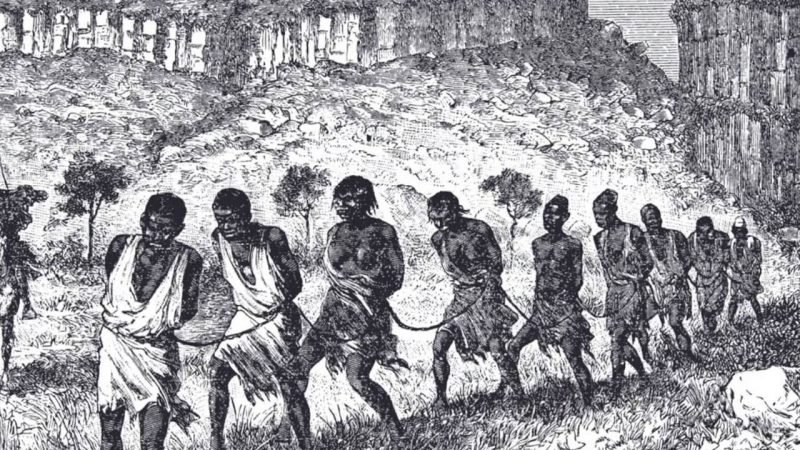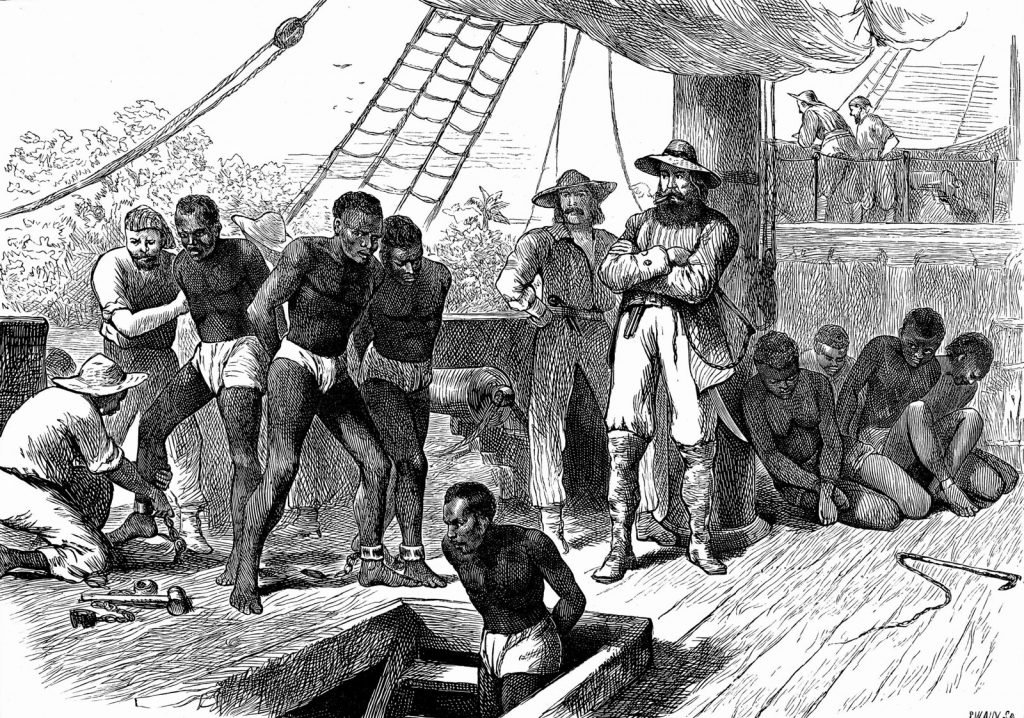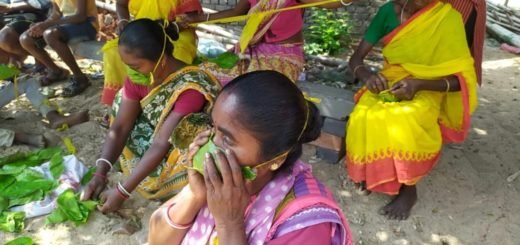African Women Slaves in Middle Passage during Transatlantic Slave Trade: The Untold Story

The trans-Atlantic slave trade during the period of 1529-1850 was one of the most significant in terms of volume and duration. About 15 million Africans, mostly along the coasts of West Africa, were forced to migrate as ‘live’ cargo to slave markets of ‘New World’ through the Middle passage known as one of the strenuous and inhuman journeys across the Atlantic Ocean. The voyage of three to four months stripped Africans of their power and dignity even before reaching the land. They were densely packed into the ships and transported to the shores of the Caribbean or America wherein they were perpetually destined to the existing system of institutional slavery. These enslaved people got chained in rows of the ship floor or on a meter-high shelves – that restricted the movement of slaves to even sit up – inside the ‘ship hulls‘. Olaudah Equiano – one of the slaves who got kidnapped as a boy from Nigeria- demonstrated on the inhumanity in The Middle Passage in his memoir. He recalls “The closeness of the place, and the heat of the climate, added to the number in the ship, which was to crowded that each had scarcely room to turn himself, almost suffocated us”. This produced copious perspirations, so that the air soon became unfit for respiration, from a variety of loathsome smells, and brought on a sickness among the slaves, of which many died — thus falling victims to the improvident avarice, as I may call it, of their purchasers”. Before the commencement of the Slave Trade, slavery existed in Africa. It was a lucrative business for African Kingdoms as well. The slaves were assembled either through kidnapping or a result of local war among the kingdoms. Then they were sold to foreign trader along with ivory and gold in exchange for weapons or other things of value.
However, in this Slave trade, there is an under-representation of women. From 15 million slaves, approximately one-third of them were deported for Trans-Atlantic slave trade. The African women endured double jeopardy of forced slavery and exploitation and discrimination being the women of colour. Slave traders and overseers exploited them by appropriating their body by homogenising their identity into slaves that initiating before the journey of Middle passage continuing till New World. European stereotypes played a fundamental role in transforming the lives and identities of African Women. Europeans perceived them into three contradictory stereotypes that are as malicious ‘whore’; slave dominated by lazy, dominant African men or in polygamous marriages and ‘powerful’ witch who metamorphosed into the rebellious slave ‘she devil’. The Black women were portrayed as muscular, masculine builds and sub-human portraits as contrary to European women’s physical frailty, delicacy and fairness. African women nakedness and ‘primitive nature’ encouraged their comparisons with the animal world. Henceforth, these stereotypes convinced the European traders that African women were different and inferior to white women, hence, justified the exploitation of their slave body for sex, childbearing and labour. Before starting of the voyage, the identities of slaves were imposed by the trade masters, which were generally black slave traders selling the already captured slaves to European slave traders, by denying them to further carry on with their personal and cultural identifiers. The slave trade masters stripped the women as well as male captives of all their clothes and other possessions they had and were made to come aboard stark naked. Hairstyles that was fundamental to the African women’s ethnic identification and social rituals of dressing hair got robbed off as they got shaved to prevent bugs. Furthermore, women went through the ritual of body scarifications such as branding and filed teeth that made them appeared as hideous canines in the eyes of European.

In the ship, the slaves were coerced to dance as part of the exercise routine also for the amusement of the sailor to ensure their subordination. Chiefly, women provided sailors with an ‘abundance of recreation’ by dancing on the quarter deck. In 1820 an American on a Brazilian ship accounted that amidst sea, the ship becomes “half bedlam, half brothel; the captain and two mates reputably ‘stripped and danced with black wenches [and] rum and lewdness reigned supreme’. In the notorious case of Captain Kimber, the teenage girl got flogged to death since she refused to dance naked on the deck of the ship. Women got lashed for other reasons as well. For instance, five-six women caught of stealing salt got whipped with ten lashes, according to the entry log of Fredensborg Slave ship. The flogging session of the black women slaves involved exposure of their body parts -hip to the thigh – that was normally kept covered by loincloth or pagne before boarding the slave ship. These women tried to maintain their modesty by squatting to hide them. The women were ‘stretched prone’ on the ground ‘in order to present more fully, uncovered … the most fleshy part of the thighs … both to the gaze of the spectator and to the incisions of the driver’ thereby offending their modesty. Some Slave women were purchased when they were pregnant and gave birth on board with the help of other slave women. However, these women weren’t allowed to practice the birth rituals of their cultures of origin. Cumulatively, the denial of practising rites on the passage led to the severance of ties between the living and ancestors, besides the retrains on the ship, disorientation, disease due to improper system of excretion and ventilation and lastly cruel inhumane punishments, took the toll on the lives of slaves and drove them crazy, women particularly. They opted for death by suicide either by starving themselves or jumping off the deck whenever the ship anchored to a new coast.
Notwithstanding, the African women slaves should not be limited to the lens of victimization since they were the earliest and active participants in resistance against slavery that was crucial in surviving Middle Passages but activities for resistance undertaken by the captive women are not documented well. The survival of African slaves was depended on the resistance attempted by the enslaved African women as maintained by the first account of Europe Naval officers. Historians have claimed that it was the captive women who initiated the planning, facilitation and organisation of some of the slave mutinies that occurred during Middle passages. It was possible with tad freedom provided to them on board. Unlike slave men who were shackled to chains and below the deck all the time, the women slave were left unchained and remained above the deck, in some cases liberty to move around the ship as they were regarded as less dangerous than slave men which provided them with resources like time to communicate and organise for the slave uprising. However, many of the resistance by the slaves wasn’t successful. For instance, John Newton – the slave captain- reported that that under his command there were at least five revolts out of which the revolt on “Thomas” slave ship in 1797 stood out. The women on board got released on the deck to exercise and eat. When these women noticed that the armoury was unlocked, they avail the opportunity by seizing the weapons and overpowered the crew members of the slave ship. The slave men were released and eventually, the ship was under the controlled of captives. But the resistance failed since they captive’s inability to navigate the seas and hence, they got recaptured. Slave women who conceived on board as a result of sexual exploitation were of higher value to the buyer in the new world because it led to an increase in the population of slaves. Thereby, women resisted either by performing infanticide or abortion to prevent their children from the future enslavement.

The deliberation on the impact of the middle passage represented the irreversible changes in women’s lives and identity. The most enduring aspects of resistance for the women slaves in the middle passage was their determination for the preservation and carrying further their cultural identity and history along with maintaining their customs and practices for which they adapted to necessary changes as enslavement demanded. They developed the skills to preserve the dignity and unity of community for which sometimes they had to endure prostitution, rape, torture and sometimes death. These enslaved women through passive and non-passive resistance opposed the silence inflicted on them by the slavery system that intended to make the slaves anonymous, voiceless and cultureless.



















